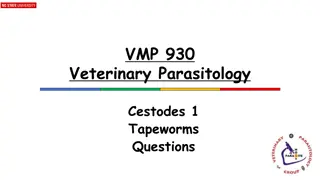Understanding Tapeworms in Veterinary Parasitology
This comprehensive guide delves into the world of cestodes, focusing on tapeworms. From the general characteristics of flatworms to the intricate life cycle of cestodes, including their presence in large and small animals, this resource provides valuable insights. Explore the morphology of different
7 views • 24 slides
Overview of Anticestodal Drugs in Veterinary Pharmacology
Anticestodal drugs play a crucial role in combating tapeworm infections in veterinary medicine. These drugs are classified into taeniafuges and taenicides, with examples of natural and synthetic compounds highlighted. Natural compounds like pumpkin seeds and male fern are traditionally used for thei
0 views • 29 slides
Understanding Echinococcus Granulosus and Hydatid Disease
Echinococcus Granulosus, also known as the hydatid worm or dog tapeworm, causes cystic echinococcosis. The tapeworm has distinct characteristics and a complex life cycle involving canids as definitive hosts and humans as accidental hosts. Hydatid disease in humans can be dangerous, with symptoms var
0 views • 8 slides
Understanding Echinococcosis: Symptoms, Transmission, and Treatment
Echinococcosis, a zoonotic disease caused by tapeworm parasites, has various forms such as cystic and alveolar echinococcosis. The disease is transmitted to humans through contaminated soil, water, or food. Diagnosis involves imaging techniques and serologic tests. Treatment options include surgery,
0 views • 9 slides
Understanding Tapeworm Infections: Cestodes Overview
Cestodes, commonly known as tapeworms, are long segmented worms with distinct morphology found in the small intestine. This comprehensive guide covers Diphyllobothrium latum, Taenia saginata, their life cycles, morphology, clinical manifestations, diagnosis, and prevention strategies. Detailed infor
1 views • 20 slides
Understanding Tapeworm Infections and Their Impact on Human Health
Tapeworms, particularly Taenia solium and Taenia saginata, are medically important cestodes that cause parasitic infections in humans. These flat, segmented worms attach to the intestinal wall and rely on intermediate hosts like cows and pigs to complete their life cycle. Infestations can lead to di
0 views • 8 slides
Understanding the Pork Tapeworm, Taenia solium: Appearance, Lifecycle, and Reproduction
The pork tapeworm, Taenia solium, is a potentially dangerous flatworm to humans, with a white ribbon-like body that can grow up to 9 meters in length. This parasite has distinct body parts including the scolex, neck, and strobilia. Humans can get infected by ingesting larvae in measly pork, leading
0 views • 18 slides
Understanding Tapeworm Infections in Veterinary Parasitology
Explore key concerns related to different tapeworm infections such as Taenia pisiformis, Taenia taeniaformis, Taenia saginata, Taenia solium, and Echinococcus. Learn about companion animal, economic, and human health concerns associated with these infections. Discover how humans can become infected
0 views • 8 slides
Overview of Platyhelminthes: Tapeworms and Flukes
Platyhelminthes, such as tapeworms and flukes, are multicellular organisms with a flat body and hermaphroditic reproductive systems. Tapeworms, a type of Cestode, have a unique structure with a scolex and proglottids for reproduction. They are dioecious and develop through the production of proglott
0 views • 24 slides
Veterinary Parasitology: Tapeworm Infections and Concerns
Explore the concerns associated with various tapeworm infections such as Taenia pisiformis, Taenia taeniaformis, Taenia saginata, Taenia solium, and Echinococcus. Learn about the risks to companion animals, economic implications, and human health consequences. Discover how humans can become infected
0 views • 8 slides









